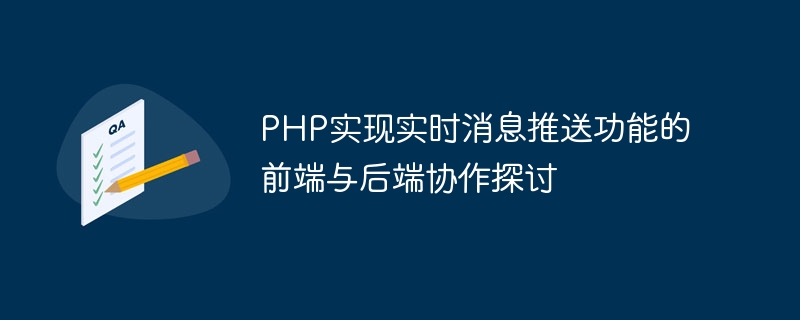

Discussion on the front-end and back-end collaboration of PHP to implement real-time message push function
Introduction:
In today's Internet era, real-time message push has become an important part of various applications An indispensable feature. It can realize functions such as instant messaging and real-time reminders, providing users with a better communication experience. This article will focus on how to use PHP to implement real-time message push functions, and explore the collaboration between the front-end and back-end.
1. Back-end implementation
When implementing the real-time message push function on the back-end, using PHP's Swoole extension can be a good choice. Swoole is a high-performance network communication framework for PHP that supports real-time message push based on the WebSocket protocol. The following are the steps to use Swoole to implement real-time message push:
Install Swoole extension
First you need to install the Swoole extension on the server, which can be installed through the following command:
pecl install swoole
Create WebSocket server
Using Swoole's WebSocket server, you can easily implement the real-time message push function. The following is a sample code to create a WebSocket server:
$server = new SwooleWebSocketServer("0.0.0.0", 9501);
$server->on('open', function (SwooleWebSocketServer $server, $request) {
echo "新的连接已建立,客户端ID:" . $request->fd . "
";
});
$server->on('message', function (SwooleWebSocketServer $server, $frame) {
echo "收到来自客户端ID为:" . $frame->fd . " 的消息:" . $frame->data . "
";
// 处理消息,并返回响应
$server->push($frame->fd, "已收到你的消息:" . $frame->data);
});
$server->on('close', function ($ser, $fd) {
echo "连接已关闭,客户端ID:" . $fd . "
";
});
$server->start();$server->push($frame ->fd, $data) can implement the logic of pushing messages to the client. You can encapsulate the message to be pushed into a $data variable according to your own business logic, and use the $server->push() method to push it. 2. Front-end implementation
The front-end implements the real-time message push function and can use JavaScript WebSocket to communicate with the back-end. The following is a sample code for the front-end to implement real-time message push:
var ws = new WebSocket("ws://your_server_ip:9501");
ws.onopen = function() {
console.log("已连接到WebSocket服务器");
};
ws.onmessage = function(e) {
console.log("收到服务器的消息:" + e.data);
// 处理收到的消息
};
ws.onclose = function() {
console.log("与WebSocket服务器的连接已关闭");
};In the above sample code, we use new WebSocket("ws://your_server_ip:9501") to establish a connection with the backend WebSocket connection. By listening to the ws.onmessage event, we can process messages pushed from the backend.
3. Front-end and back-end collaboration
When implementing the real-time message push function, the front-end and back-end need to collaborate to maintain the stability of real-time communication. The following is the workflow of front-end and back-end collaboration:
$server->push() method, and the frontend can listen to WebSocket's ws.onmessageEvents are used to receive messages pushed by the backend and perform related processing. ws.close() method. Conclusion:
Real-time message push function through PHP can provide better user experience and communication effect. The WebSocket server extended by Swoole can easily implement the back-end message push logic, and the front-end can communicate with the back-end in real time through JavaScript's WebSocket. The collaboration between the front and back ends enables the real-time message push function to provide users with a better application experience.
References:
The above is the detailed content of Discussion on front-end and back-end collaboration to implement real-time message push function in PHP. For more information, please follow other related articles on the PHP Chinese website!
 Is python front-end or back-end?
Is python front-end or back-end?
 How to implement instant messaging on the front end
How to implement instant messaging on the front end
 The difference between front-end and back-end
The difference between front-end and back-end
 Introduction to the main work content of the backend
Introduction to the main work content of the backend
 Introduction to the relationship between php and front-end
Introduction to the relationship between php and front-end
 Ethereum browser query digital currency
Ethereum browser query digital currency
 Solution to split word table into two pages
Solution to split word table into two pages
 What are the levels of mobile user star ratings?
What are the levels of mobile user star ratings?